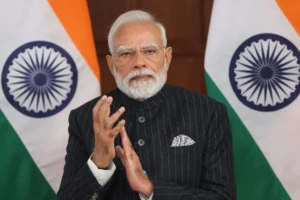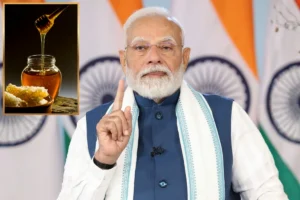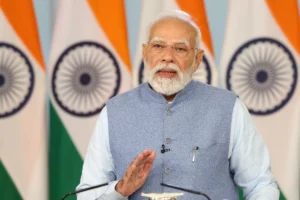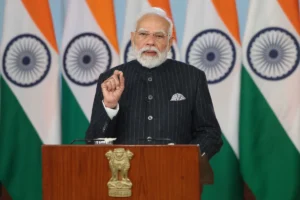
India’s exports are the most resilient among the top 20 worldwide exporters, according to a research report by the PHD Chamber of Commerce and Industry, which is a big finding. The analysis highlights the remarkable expansion of exports, with rates of 20 percent in 2021 and 9.7 percent in 2022, respectively, representing the largest increase among top exporting countries.
The dynamic policy climate created by the government and exporters’ deliberate efforts to integrate with global value chains are cited by Sanjeev Agrawal, President of the Chamber of Commerce and Industry, for this outstanding achievement. He was upbeat about the direction of export development, particularly though October 2023 saw a noteworthy 9% increase following a brief decline.
India’s exports have increased dramatically during the last ten years, rising from USD 375 billion in FY 2011 to USD 770 billion in FY 2023. The goal of the introduction of India’s new Foreign Trade Policy (FTP) 2023 is to establish an environment that would support exporters. It is distinguished by five essential components: duration, dynamicism, decentralization, direction, and disaster-proofing.
Also Read: SC warns Patanjali of making “false” & “misleading” Ads; company says, give death sentence if guilty
The Executive Director of the PHD Chamber of Commerce and Industry, Dr. Ranjeet Mehta, emphasized that the goal of FTP 2023 is to make India more competitive in the world market, which is in line with the aim of being “Atmanirbhar” (self-reliant).
Mehta stated: “The goal of the introduction of India’s new Foreign Trade Policy (FTP) 2023 is to establish an environment that will support exporters. It consists of five essential components: duration, dynamicism, decentralization, direction, and disaster proofing. It will increase India’s export volume while taking the country’s size and manufacturing and service industry base into account.
Mehta noted, “The FTP 2023 aims to increase India’s competitiveness in the global markets by promoting and developing each state to be able to integrate with the global trade which is a move in line with India’s vision of becoming “Atmanirbhar” (self-reliant).”
“The emerging high growth destinations such as Togo, Netherlands, Brazil, Israel, Indonesia, Turkey, Australia, South Africa, Saudi Arabia and Belgium and high growth export commodities such as Sugar and confectionary, Mineral fuel and oils, aluminium and articles, inorganic chemicals, ships, boats and floating structure, rubber and articles and optical, photographic, medical apparatus would enhance India’s export growth to new highs” , Mehta stated.
Also Read: Vande Bharat passengers slammed by railway official for misusing amenities
The FTP 2023 is centered on helping every state engage with international trade and advance sustainable, low-carbon economic development. Newly popular high-growth travel destinations include Togo, the Netherlands, Brazil, Israel, Indonesia, Turkey, Australia, South Africa, Saudi Arabia, and Belgium, according to the research. Furthermore, a substantial portion of India’s export growth is anticipated to come from high-growth export commodities including sugar and confectionary, mineral fuel and oils, electrical gear and parts, aluminum and articles, and more.
Sanjeev Agrawal highlighted how the top 10 export items and destinations have grown steadily over the previous five years. With an astounding 73% rise, Togo tops the list, followed by the Netherlands, Brazil, Israel, and other countries.
According to Aggarwal, “Despite the global economic slowdown, exports to these countries have grown at a high growth rate.” These nations are starting to become important growth markets for India’s exports, but in the near future, the volumes need to increase even more. India’s export growth could reach all-time highs thanks to the high growth, high volume export goods.” Despite their rapid expansion, these commodities and destinations offer potential for future volume increases.
The research also lists 75 products that, in FY 2023, accounted for roughly half of India’s total exports.
The Chamber of Commerce and Industry’s Chief Economist, Dr. SP Sharma, noted that although these items have enormous potential, they now account for barely 6% of global exports.
Based on a six-digit Harmonized system (HS code), the industry organization selected 75 products. These commodities make up almost 50% of India’s total exports for the FY 2023, indicating that they have a significant potential to increase India’s exports. Nevertheless, as these commodities only account for 6% of all exports, India can increase its exports of these goods in order to fully explore the enormous unrealized potential in international markets. Dr. Sharma stated, “These 75 products exports total USD 222 billion in a world of USD 3838 billion in exports.”
He believes there is a lot of possibility for India to increase its exports of these goods and take advantage of the unexplored international markets.
Over the previous two years, services exports have grown at an average pace of 24%, demonstrating remarkable resilience and price competitiveness.
Also Read: Health emergency in China, outbreak of another mysterious disease after Covid-19
Dr. Sharma emphasized the need of services exports as a key engine of growth in order to meet the challenging goal of USD 2 trillion in exports by 2030.
In order to reach the USD 2 trillion target, Agrawal emphasized the need of government-initiated changes and the ease of doing exports.
He underlined the necessity for well-balanced changes while addressing the costs associated with conducting business, which include labor, power, capital, and the availability of land.
Furthermore, it was determined that pursuing new Free Trade Agreements (FTAs) with the UK and the EU would be a key strategy to increase India’s involvement in global value chains.
To read more such news, download Bharat Express news apps




















